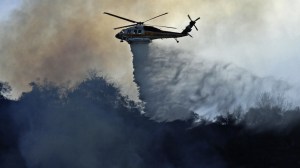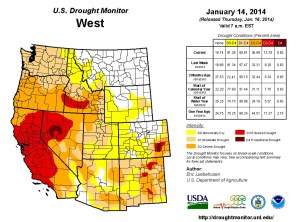California Gov. Jerry Brown declared a “drought state of emergency” on Friday due to ongoing water shortfalls following the driest calendar year in state history.

The governor said the state was facing perhaps the worst drought since records have been kept.
“We can’t make it rain, but we can be much better prepared for the terrible consequences that California’s drought now threatens, including dramatically less water for our farms and communities and increased fires in both urban and rural areas,” Brown said. “I’ve declared this emergency and I’m calling all Californians to conserve water in every way possible.”
Noting that water supplies in state reservoirs were below record lows and statewide snowpack was at 20 percent of average water content, Brown told state agencies to use less water and promote awareness about conservation.
He asked for Californians in both rural and urban areas to cut their water use by at least a fifth.
“Everyone should try to do at least 20 percent conservation,” he said at a news conference.
The declaration comes as firefighters battled a wildfire in the San Gabriel Mountains that spread in part due to extremely dry vegetation. The Colby Fire was at 1,700 acres Friday, and a red flag warning was extended to 6 p.m. Saturday.

Federal forecasters’ seasonal drought outlook has predicted that California’s drought will worsen or persist. The U.S. Drought Monitor, released Thursday, showed most of the state in “extreme drought,” the fourth-worst of five categories.
The full text of Brown’s emergency proclamation is below:
A PROCLAMATION OF A STATE OF EMERGENCY
WHEREAS the State of California is experiencing record dry conditions, with 2014 projected to become the driest year on record; and
WHEREAS the state’s water supplies have dipped to alarming levels, indicated by: snowpack in California’s mountains is approximately 20 percent of the normal average for this date; California’s largest water reservoirs have very low water levels for this time of year; California’s major river systems, including the Sacramento and San Joaquin rivers, have significantly reduced surface water flows; and groundwater levels throughout the state have dropped significantly; and
WHEREAS dry conditions and lack of precipitation present urgent problems: drinking water supplies are at risk in many California communities; fewer crops can be cultivated and farmers’ long-term investments are put at risk; low-income communities heavily dependent on agricultural employment will suffer heightened unemployment and economic hardship; animals and plants that rely on California’s rivers, including many species in danger of extinction, will be threatened; and the risk of wildfires across the state is greatly increased; and
WHEREAS extremely dry conditions have persisted since 2012 and may continue beyond this year and more regularly into the future, based on scientific projections regarding the impact of climate change on California’s snowpack; and
WHEREAS the magnitude of the severe drought conditions presents threats beyond the control of the services, personnel, equipment and facilities of any single local government and require the combined forces of a mutual aid region or regions to combat; and
WHEREAS under the provisions of section 8558(b) of the California Government Code, I find that conditions of extreme peril to the safety of persons and property exist in California due to water shortage and drought conditions with which local authority is unable to cope.
NOW, THEREFORE, I, EDMUND G. BROWN JR., Governor of the State of California, in accordance with the authority vested in me by the state Constitution and statutes, including the California Emergency Services Act, and in particular, section 8625 of the California Government Code HEREBY PROCLAIM A STATE OF EMERGENCY to exist in the State of California due to current drought conditions.
IT IS HEREBY ORDERED THAT:
1.State agencies, led by the Department of Water Resources, will execute a statewide water conservation campaign to make all Californians aware of the drought and encourage personal actions to reduce water usage. This campaign will be built on the existing Save Our Water campaign (www.saveourh20.org) and will coordinate with local water agencies. This campaign will call on Californians to reduce their water usage by 20 percent.
2.Local urban water suppliers and municipalities are called upon to implement their local water shortage contingency plans immediately in order to avoid or forestall outright restrictions that could become necessary later in the drought season. Local water agencies should also update their legally required urban and agricultural water management plans, which help plan for extended drought conditions. The Department of Water Resources will make the status of these updates publicly available.
3.State agencies, led by the Department of General Services, will immediately implement water use reduction plans for all state facilities. These plans will include immediate water conservation actions, and a moratorium will be placed on new, non-essential landscaping projects at state facilities and on state highways and roads.
4.The Department of Water Resources and the State Water Resources Control Board (Water Board) will expedite the processing of water transfers, as called for in Executive Order B-21-13. Voluntary water transfers from one water right holder to another enables water to flow where it is needed most.
5.The Water Board will immediately consider petitions requesting consolidation of the places of use of the State Water Project and Federal Central Valley Project, which would streamline water transfers and exchanges between water users within the areas of these two major water projects.
6.The Department of Water Resources and the Water Board will accelerate funding for water supply enhancement projects that can break ground this year and will explore if any existing unspent funds can be repurposed to enable near-term water conservation projects.
7.The Water Board will put water right holders throughout the state on notice that they may be directed to cease or reduce water diversions based on water shortages.
8.The Water Board will consider modifying requirements for reservoir releases or diversion limitations, where existing requirements were established to implement a water quality control plan. These changes would enable water to be conserved upstream later in the year to protect cold water pools for salmon and steelhead, maintain water supply, and improve water quality.
9.The Department of Water Resources and the Water Board will take actions necessary to make water immediately available, and, for purposes of carrying out directives 5 and 8, Water Code section 13247 and Division 13 (commencing with section 21000) of the Public Resources Code and regulations adopted pursuant to that Division are suspended on the basis that strict compliance with them will prevent, hinder, or delay the mitigation of the effects of the emergency. Department of Water Resources and the Water Board shall maintain on their websites a list of the activities or approvals for which these provisions are suspended.
10. The state’s Drinking Water Program will work with local agencies to identify communities that may run out of drinking water, and will provide technical and financial assistance to help these communities address drinking water shortages. It will also identify emergency interconnections that exist among the state’s public water systems that can help these threatened communities.
11.The Department of Water Resources will evaluate changing groundwater levels, land subsidence, and agricultural land fallowing as the drought persists and will provide a public update by April 30 that identifies groundwater basins with water shortages and details gaps in groundwater monitoring.
12.The Department of Water Resources will work with counties to help ensure that well drillers submit required groundwater well logs for newly constructed and deepened wells in a timely manner and the Office of Emergency Services will work with local authorities to enable early notice of areas experiencing problems with residential groundwater sources.
13.The California Department of Food and Agriculture will launch a one-stop website (www.cdfa.ca.gov/drought) that provides timely updates on the drought and connects farmers to state and federal programs that they can access during the drought.
14.The Department of Fish and Wildlife will evaluate and manage the changing impacts of drought on threatened and endangered species and species of special concern, and develop contingency plans for state Wildlife Areas and Ecological Reserves to manage reduced water resources in the public interest.
15. The Department of Fish and Wildlife will work with the Fish and Game Commission, using the best available science, to determine whether restricting fishing in certain areas will become necessary and prudent as drought conditions persist.
16.The Department of Water Resources will take necessary actions to protect water quality and water supply in the Delta, including installation of temporary barriers or temporary water supply connections as needed, and will coordinate with the Department of Fish and Wildlife to minimize impacts to affected aquatic species.
17.The Department of Water Resources will refine its seasonal climate forecasting and drought prediction by advancing new methodologies piloted in 2013.
18.The California Department of Forestry and Fire Protection will hire additional seasonal firefighters to suppress wildfires and take other needed actions to protect public safety during this time of elevated fire risk.
19.The state’s Drought Task Force will immediately develop a plan that can be executed as needed to provide emergency food supplies, financial assistance, and unemployment services in communities that suffer high levels of unemployment from the drought.
20.The Drought Task Force will monitor drought impacts on a daily basis and will advise me of subsequent actions that should be taken if drought conditions worsen.
I FURTHER DIRECT that as soon as hereafter possible, this Proclamation be filed in the Office of the Secretary of State and that widespread publicity and notice be given of this Proclamation.